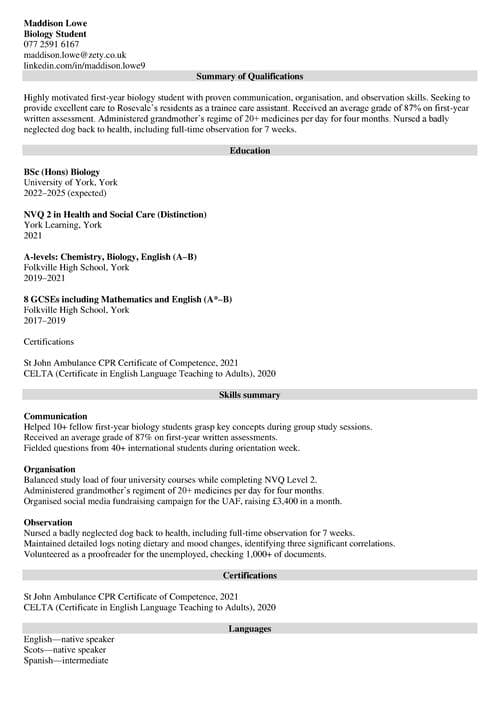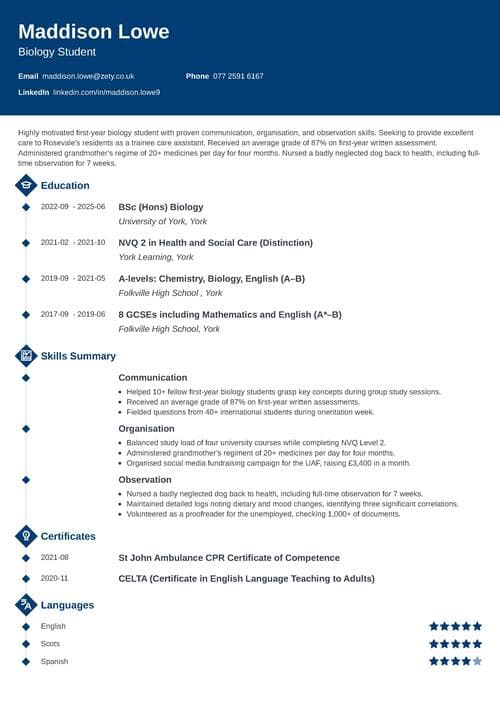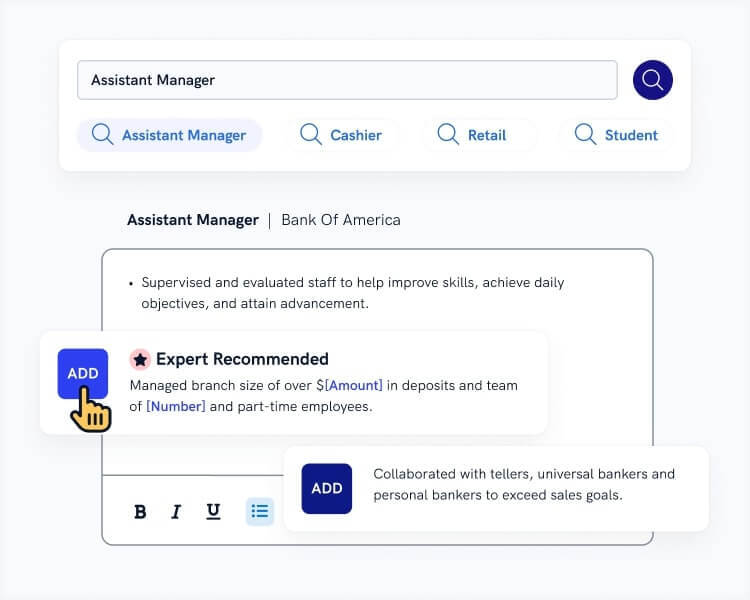How to Write a CV With No Experience in 2026 + Examples
Create your CV nowNo work experience, but still want to earn some pounds? While employers usually expect to see a work history on a CV, not having one doesn’t mean you won’t find a job. You can still impress recruiters with a no-experience CV!
If you’re looking for excellent CV examples for students with no experience, or CV samples for other candidates, you’re in the right place. Read on!
This guide will show you:
- Sample CVs with no experience that are better than 9 out of 10 of those out there.
- How to write a CV for a job with no experience and land job interviews.
- Tips and examples of how to put skills and achievements on a no-experience CV.
- What to put on a CV with no experience to get any entry-level job you want.
Want to save time and have your CV ready in 5 minutes? Try our CV builder. It’s fast and easy to use. Plus, you’ll get ready-made content to add with one click. See 20+ CV templates and create your CV here.
Sample CV made with our builder—See more CV examples and create your CV here.
First, let’s see examples of CVs with no work experience.
CV example for a student with no experience
Maddison Lowe
Biology Student
077 2591 6167
maddison.lowe@email.com
linkedin.com/in/maddison.lowe9
Objective
Highly motivated first-year biology student with proven communication, organisation, and observation skills. Received an average grade of 87% on the first-year written assessment. Administered grandmother’s regime of 20+ medicines per day for four months. Nursed a badly neglected dog back to health, including full-time observation for 7 weeks. Seeking to provide excellent care to Rosevale’s residents as a trainee care assistant.
Skills Summary
Communication
- Helped 10+ fellow first-year biology students grasp key concepts during group study sessions.
- Received an average grade of 87% on first-year written assessments.
- Fielded questions from 40+ international students during orientation week.
Organisation
- Balanced study load of four university courses while completing NVQ Level 2.
- Administered grandmother’s regimen of 20+ medicines per day for four months.
- Organised a social media fundraising campaign for the UAF, raising £3,400 in a month.
Observation
- Nursed a badly neglected dog back to health, including full-time observation for 7 weeks.
- Maintained detailed logs noting dietary and mood changes, identifying three significant correlations.
- Volunteered as a proofreader for the unemployed, checking 1,000+ documents.
Education
BSc (Hons) Biology
University of York, York
2023–2026 (expected)
NVQ 2 in Health and Social Care (Distinction)
York Learning, York
2022
A-levels: Chemistry, Biology, English (A–B)
Folkville High School, York
2020–2022
8 GCSEs including Mathematics and English (A*–B)
Folkville High School, York
2018–2020
Certifications
- St John Ambulance CPR Certificate of Competence, 2022
- CELTA (Certificate in English Language Teaching to Adults), 2021
Languages
- English—native speaker
- Scots—native speaker
- Spanish—intermediate
This CV with no experience example is ideal for students or young people with limited formal experience but strong transferable skills.
✅ Here’s what makes it effective:
- Strong alignment with care-related roles through real-world examples like administering medication and animal nursing.
- Well-rounded academic background highlighted with top assessment scores and a relevant NVQ.
- Skills-based structure suits candidates without professional experience but with personal achievements.
- Extracurriculars and volunteering build credibility in observation and responsibility.
- Clear, tailored objective shows intent and readiness for a trainee care assistant position.
Sample CV with no experience: internship candidate
James Ali
BA Marketing Undergraduate
james.ali@email.com
07400 123456
linkedin.com/in/james-ali
Personal Statement
Results-driven second-year marketing student with a blend of creative thinking and data-driven analysis. Skilled in social media strategy, content creation, and market research, with hands-on experience from university-led campaigns. Eager to bring fresh insights and strong execution skills to BrightPixel Digital as a summer intern, supporting client projects with enthusiasm, adaptability, and a keen understanding of digital trends.
Skills Summary
Creativity
- Designed marketing materials for a university society event, boosting attendance by 40%.
- Created a weekly podcast, writing scripts and editing episodes using Audacity.
Digital Skills
- Managed an Instagram account for a student club, increasing followers from 80 to 250 in 3 months.
- Completed HubSpot Academy certifications in Email Marketing and SEO.
Research & Analysis
- Conducted user research for a group coursework project using surveys and interviews.
- Analysed engagement metrics using Google Analytics for a personal blog project.
Education
Bachelor of Arts (Hons) Marketing
University of Leeds (2022–2025)
- Modules: Digital Marketing, Consumer Behaviour, Data Analytics
- Average Grade: 74% (2:1)
Certifications
- HubSpot Inbound Marketing Certificate (2024)
- Google Digital Garage – Fundamentals of Digital Marketing (2023)
Languages
- English—native
- Urdu—fluent
- French—basic
This CV with no experience example is ideal for university students applying for internships.
✅ Here’s what makes it effective:
- Focused personal statement that connects academic studies with career goals in a relevant field.
- Emphasis on relevant skills such as social media management, podcasting, and certifications demonstrates initiative and technical ability.
- Practical examples of impact, like boosting Instagram followers and event turnout, make achievements measurable.
- Academic modules listed to showcase the theoretical foundation in marketing.
- Industry-recognised certifications like HubSpot and Google add credibility and modern relevance.
CV example with no work experience: applying for first job
Leanne Smith
Recent College Leaver – Eager Customer Service Trainee
leanne.smith@email.com
07900 889000
Personal Statement
Reliable and quick-learning college leaver with a strong interest in customer-facing roles and a natural ability to resolve problems efficiently. Recognised for clear communication, calm under pressure, and a proactive approach to helping others. Eager to contribute to the customer success team at NovaConnect Solutions, providing outstanding service while developing long-term skills in a fast-paced, client-focused environment.
Skills Summary
Problem-Solving
- Handled enquiries at a college open day booth, resolving questions from 50+ attendees.
- Supported younger students during peer mentoring, identifying learning barriers.
Communication
- Presented group projects confidently in front of class; received top marks for clarity.
- Responded to customer emails during a one-week work experience at a local travel agency.
Reliability
- Maintained 100% attendance during sixth form.
- Volunteered at a local food bank every Saturday for six months.
Education
BTEC Level 3 National Diploma in Business (D*D)
Manchester College (2022–2024)
- Key Units: Customer Service, Marketing Principles, Financial Planning
- Final Project: Developed a mock customer feedback app prototype
Certifications
- Level 2 Certificate in IT User Skills (ECDL)
- First Aid (British Red Cross, 2023)
Hobbies
- Reading business case studies
- Learning new tech tools (e.g., Canva, Trello)
This CV with no experience example is ideal for school or college leavers seeking entry-level roles.
✅ Here’s what makes it effective:
- Friendly tone and focus on relevant skills (e.g. communication, problem-solving) fit well with customer service roles.
- Evidence of responsibility through volunteering and attendance builds employer trust.
- Work experience and peer support examples show transferable, workplace-relevant skills.
- Straightforward layout and accessible language suit early-career candidates.
- Inclusion of hobbies and tech interests adds personality and shows self-motivation.
Now, let’s see how to make a CV for a job with no experience that will help you get the career you’re after.
1. Choose the best format for a CV with no experience
Having no work experience for a CV doesn’t mean your job application has to look amateur. Using the skills-based CV format is ideal in 2025 for candidates with limited experience. It shifts the focus away from work history and toward what really matters: your skills.
Here’s how to format a no-experience CV:
- Use clear sections: CV header (with yourpersonal details), personal statement, skills summary, education section, and extra sections (such as hobbies & interests, language skills, certificates, etc.).
- Choose a professional font (e.g., Calibri, Arial, or Times New Roman) at 11–12 pt.
- Keep margins and spacing consistent for readability.
- Name your file in a way that will make the recruiter’s life easier (e.g., “MaddisonLowe_TraineeCareAssistant_CV.pdf”).
Online profiles – LinkedIn in particular – are likely to be screened by recruiters, even if you don’t include them. Make sure they reflect your best self.
Read more: CV Format: Examples & Everything You Need to Know
2. Summarise your skills: the backbone of any CV with no experience
How to write a CV for a job with no experience? You won’t highlight work experience, that’s for sure. But there’s one thing that can persuade the recruiters as much as great work history. It’s your skills.
💡 Professional skills fall into two categories: hard skills and soft skills. A well-thought-out CV combines these two.
How to highlight skills on a CV with no experience?
- Pick 3–5 key skills that match the kind of job you want. Think about what you're good at, like communication, teamwork, or organisation.
- Check the job advert and see which skills the employer is asking for. Choose the ones you also have – these will be your main “headline skills.”
- Make each skill bold and give it space to stand out. Treat them like mini-headlines on your CV.
- Add 2–5 bullet points under each skill. In each one, give a short example of how you've used that skill before at school, in volunteering, or in everyday life.
- Use numbers if you can. For example, say “Organised a study group of 8 people” instead of just “Organised study groups.”
- Start each bullet point with an action verb, like “led,” “created,” “managed,” or “solved.”
- Use accomplishment-style bullet points to show not just what you did, but what the result was.
These are skills that are good for any CV:
Best skills for a no-experience CV
- Resilience
- Communication Skills
- Analytical Skills
- Leadership Skills
- Teamwork
- Interpersonal Skills
- Self-Management
- Organisation
- Observation
- Active-Listening Skills
- Problem-Solving
- Decision-making
- Creativity
- Planning and Research Skills
- Ability to Learn
- IT Skills
- Computer Skills
- Customer Service Skills
Okay, now that you know what some of the best CV skills are, let’s see them in action.
Sample CV with no experience: skills summary
Skills summary
Communication
- Helped 10+ fellow first-year biology students grasp key concepts during group study sessions.
- Received an average grade of 87% on first-year written assessments.
- Fielded questions from 40+ international students during orientation week
Organisation
- Balanced study load of four university courses while completing NVQ Level 2.
- Administered grandmother’s regimen of 20+ medicines per day for four months.
- Organised social media fundraising campaign for the UAF, raising £3,400 in a month.
Observation
- Nursed a badly neglected dog back to health, including full-time observation for 7 weeks.
- Maintained detailed logs noting dietary and mood changes, identifying three significant correlations.
- Volunteered as a proofreader for the unemployed, checking 1,000+ documents.
When making a CV in our builder, drag & drop bullet points, skills, and auto-fill the boring stuff. Spell check? Check. Start building a professional CV template here for free.
When you’re done, Zety’s CV builder will score your CV and tell you exactly how to make it better.
3. Spotlight your education
The reason there are so many CV examples for students with no experience out there is that students are the most likely to be looking for their first job. But whether you’re still studying, just graduated, or finished school years ago, the education section is an essential part of your CV.
How to list educational background on a no-experience CV?
- Create an entry for each of the secondary and post-secondary qualifications.
- List the name of the qualification, the awarding institution, and the dates you attended there. Include an expected graduation or completion date if you’re still studying.
- Put all these qualifications in reverse chronological order – from most recent to least. It’s one of the evergreen tips for writing a great CV.
- List your A-levels, but only state the number of GCSEs. Put “including Mathematics and English” after the number of GCSEs. Some employers need to see that you’ve passed at least these two.
CV examples for students with no experience: education section
BSc (Hons) Biology
University of York, York
2022–2025 (expected)
NVQ 2 in Health and Social Care (Distinction)
York Learning, York
2021
A-levels: Chemistry, Biology, English (A–B)
Folkville High School, York
2019–2021
8 GCSEs including Mathematics and English (A*–B)
Folkville High School, York
2017–2019
💡 Pro Tip: If you’re wondering how many pages a CV should be, here’s the answer: an ideal length for candidates with no work experience is a one-page CV.
4. Boost your no-experience CV with extra sections
In a CV with no experience, all that can set you apart from other candidates is the skills summary and education section. That’s not much. Say you’re writing an IT CV: there are a lot of people who are good with computers studying IT degrees.
You need to stand out from the crowd and show that you’re particularly well-suited to the role. Adding more sections to a CV does both of these things. Of course, you have to know what to add.
🥇 Here are two golden rules:
- Every single “extra” thing in your CV has to be clearly and directly relevant to the job application at hand. This means there’s no one-size-fits-all solution.
- Add 2–4 CV sections. Don’t mention every single achievement. Try to focus on what’s really impressive, relevant, and beneficial for potential employers.
Additional sections on a CV without work experience can include:
- Certification and Licenses. Even without a lot of experience, these prove that you’re more than ready to start gaining it.
- Language skills are always relevant, impressive and can work great to your advantage as only 20% of Britons can speak a foreign language fluently.
- Conferences you’ve attended will show that you’re willing to keep learning – this personal trait is a must for every inexperienced candidate.
- Volunteering. Volunteer work shows your character more than any other CV entry. It’s precisely what makes a good CV that will impress every recruiter.
- Hobbies and interests, especially if relevant to the opening, are a great addition to a CV with no experience. They can also often back up your hard and soft skills.
- Awards will show that you’ve accomplished something outstanding and worth recognition.
CV for a teenager with no experience: sample additional CV sections
Certifications
- St John Ambulance CPR Certificate of Competence
- CELTA (Certificate in English Language Teaching to Adults)
Languages
- English – native speaker
- Scots – native speaker
💡 Don’t miss anything that can be beneficial for your application. Read our guide: What to Include in a CV
5. Collect the best bits together to create an impressive objective for a CV with no experience
All the heavy lifting is done at this point. Let's go back to the top of your CV and create a CV objective, otherwise known as a personal statement. It’s a short paragraph that grabs the recruiters’ attention and keeps them reading.
How to create a no-experience CV objective?
- Write it last. After finishing your CV, scan it for the most relevant strengths and achievements.
- Start with 1–2 adjectives that match the job. Think “reliable,” “driven,” “detail-oriented” – but only use ones that can be backed up with examples.
- Pick 2–3 standout skills or accomplishments from your CV that align directly with the job ad. Focus on what’s most useful to the employer.
- End with a clear statement about what you want to contribute to this specific company or role. Mention the employer by name and tailor your goal to their needs.
All the tips above mean structuring the CV personal profile using the following formula:
Adjective + Student or Graduate Status (if any) + Achievements and/or Skills + What You Want to Do for the Employer
CV with no work experience examples: CV objective
Motivated first-year biology student with strong communication, organisation, and observation skills developed through both academic and personal caregiving experience. Achieved an 87% average on first-year university assessments, demonstrating attention to detail and commitment to learning. Provided full-time care for a relative, safely managing a complex medication schedule of 20+ prescriptions over four months. Restored the health of a neglected dog through seven weeks of dedicated monitoring and care. Eager to bring compassion, reliability, and initiative to the team at Rosevale Care Home as a trainee care assistant.
💡 Read more about writing an interview-winning CV objective: How to Write a CV Personal Statement
6. Attach a cover letter to your CV with no experience
First things first: have you been explicitly told in the job ad not to include a cover letter? No? Then forget everything you’ve heard about employers not bothering to read cover letters. Remember: when writing a CV with no work experience, it’s even more important to attach a cover letter. It’s your invaluable opportunity to convince the employer that you’re the right person for the role.
Here’s how to write a cover letter for a CV with no experience:
- Begin your cover letter strongly to grab the reader’s attention from the top.
- Make sure you’ve got all the parts of a cover letter:
- Contact section
- Professional salutation
- Personal introduction
- Evidence of how the company will benefit from hiring you,
- Keep the cover letter length. One page, four paragraphs, 300 words is an ideal one.
- Adhere to the best practices of cover letter formatting.
- End your cover letter with a call to action. Offer a precise date for an interview.
- Sign off with your full name. If you’re handling a hard copy of it, include a handwritten sign-off.
And that’s it. Now you know not only how to write a CV for a job with no experience but also how to write a strong, short cover letter. That’s the perfect recipe for boosting your chances of getting that dream job!
💡 Just graduated? About to write your first cover letter? Read more: Recent Graduate Cover Letter
Looking for CV examples for specific jobs or circumstances? See some of our related posts:
- Hospitality CV Example
- Receptionist CV Example
- Waiter / Waitress CV Example
- Shop Assistant CV Example
- Personal Trainer CV Example
- Internship CV Example
- Student CV Example
- Graduate CV Example
- School Leaver CV Example
- CV for a 16-Year-Old
- CV for a Part-Time Job
- 100+ CV Examples for Every Industry
Plus, a great cover letter that matches your CV will give you an advantage over other candidates. You can write it in our cover letter builder here. Here's what it may look like:
See more cover letter templates and start writing.
Key takeaways
You don’t need job experience to write a strong CV – just a clear strategy and the right focus.
✅ Here’s a quick recap of how to make a CV with no experience:
- Choose the correct CV format: a skills-based CV is ideal when experience is limited.
- Build a strong skills summary with real-life examples that prove your value.
- Present your education effectively: treat academic work as CV-worthy achievements.
- Build a tailored CV objective that shows exactly what you’ll bring to the role.
- Include a cover letter to reinforce your strengths and interest in the position.
You now have a CV that can open doors. Stay confident, apply widely, and when experience does come, your next CV will be even stronger. Good luck – you’re ready!
About Zety’s Editorial Process
This article has been reviewed by our editorial team to make sure it follows Zety's editorial guidelines. We’re committed to sharing our expertise and giving you trustworthy career advice tailored to your needs. High-quality content is what brings over 40 million readers to our site every year. But we don't stop there. Our team conducts original research to understand the job market better, and we pride ourselves on being quoted by top universities and prime media outlets from around the world.







![15 One Page CV Templates [Examples of 1 Page Format]](https://cdn-images.zety.com/pages/one_page_cv_templates_zety_uk_18.jpg?fit=crop&h=250&dpr=2)